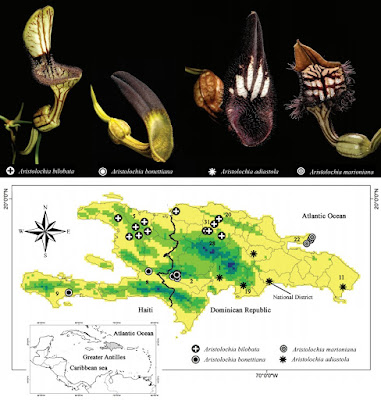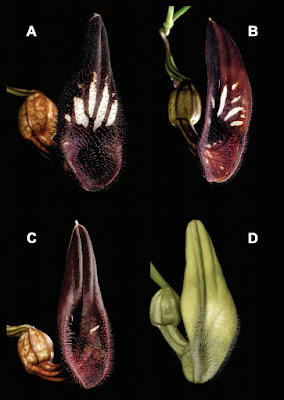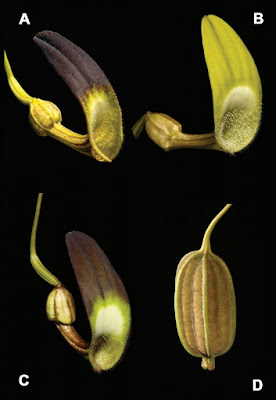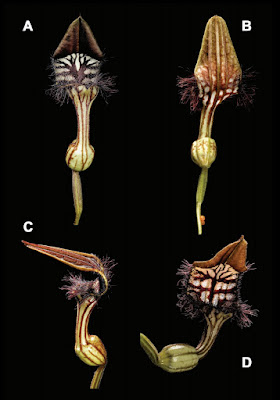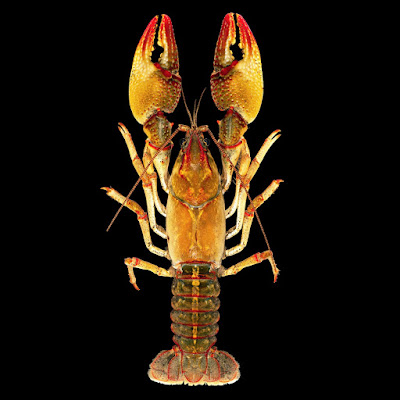[Most Recent Entries] [Calendar View]
Wednesday, October 9th, 2019
| Time | Event | ||||
| 6:02a | [Botany • 2019] Aristolochia (Aristolochiaceae) of Hispaniola Abstract A review of the literature at large and the field photographic record of the senior author of this study indicate that there are several undescribed species of Aristolochia in Hispaniola (Dominican Republic and Haiti), related to A. bilobata. Here we show that A. mirandae is a synonym of A. bilobata and that what appears as A. bilobata in Marión H. (2011: 76–77) is a new species here described as Aristolochia adiastola. In addition, two new species, A. bonettiana and A. marioniana, also related to A. bilobata, are described and illustrated herein. Key words: Aristolochia, Aristolochiaceae, hexandrous, West Indies Aristolochia adiastola G.A. Romero & E. Fernández, sp. nov. Aristolochia adiastola differs from A. bilobata by the absence of a constriction between the limb and the tube, the color of the limb (purple to brown with white spots in the new species versus greenish to yellowish with purple veins in A. bilobata), the orientation of the flowers, and their allopatric distribution. Etymology:— From the Greek ἁδιαστολή, adiastolos, “not separated, confused” (Brown 1954: 228). An examination of herbarium specimens from A, GH, JBSD, NY, US, and USD (herbarium acronyms cited according to Thiers, continuously updated), filed under Aristolochia bilobata, as well as a search of images on the Internet under “Aristolochia bilobata”, revealed a mixture of A. adiastola, A. bilobata, and several undescribed species. This confusion can be traced back to the fact that A. bilobata was thought not to have any close relatives (Rankin and Greuter 1999) and that “while this species was frequently collected without flowers or fruits, it could be readily identified by the curious bilobate leaves” (Pfeifer 1966). Following these criteria, all plants from Hispaniola bearing bilobate leaves were at first identified, albeit often incorrectly, as A. bilobata. As pointed out above, in vivo, Aristolochia adiastola can be easily distinguished from A. bilobata based on the color and orientation of the flowers (Fig. 4). Regarding orientation, the utricle is always pendant and the tube horizontal to pendant in A. adiastola; the former is always horizontal, and the latter erect in A. bilobata. Flower buds of A. adiastola start with the largest medial lobe abaxial (“1” in Pfeifer 1966: figure 2 therein; “a” in González 1999: 54, figure 12 therein); a flexure downward and a twist in the peduncle make the ovary and utricle pendant, and a slight bending upward of the tube relative to the utricle makes the tube horizontal to pendant and the medial lobe of the calyx adaxial and vertical (Figs. 3, 4). It is not clear whether the “twist” mentioned above always occurs in the peduncle: it is sometimes evident in the ovary (Fig. 4B, C). Flowers of his species change shape in function of their development. At anthesis, early in the day, the edges of the limb are not revolute (Fig. 4B); by noon the edges are conspicuously revolute (Fig. 4A, B, C; in the afternoon, the edges of the limb bent forward, as the flower becomes senescent. The white spots on the limb of flowers of the new species vary from inconspicuous, small, to conspicuous, horizontal to transversal, white spots. Likewise, the density and length of the multicellular trichomes along the basal margin of the limb also vary considerably (Fig. 3). A collaborator of the senior author recently found a population of A. adiastola the plants of which bore totally green flowers, with subtle lighter green spots at the base of the limb (Fig. 4D). The specimen collected by O. P. Swartz at SBT (11433, Ex Ind. Occident., as “Aristolochia bilobata Linn.” [image seen]) has two deteriorated flowers that yet show somewhat the limb shape of A. adiastola but, according to the senior author of this contribution, it may be referable to an undescribed species from Haiti. Two other specimens attributed to Swartz and identified as A. bilobata, one at B (B-W 17050-01 0 [image seen]), with one deteriorated, undeterminable flower and a fragment of another one in the convolute, based on its size possibly belonging to another species, and one at S (08-1029 [image seen]) bears leaves only; another one at S [08-1032 [image seen]) bears only leaves and a fruit (with seeds in the packet). Field and herbarium diagnostic characters:— In vivo, at anthesis, utricle pendant, tube horizontal to pendant, limb erect, purple to brownish red with white spots of variable size, without a constriction, the margins revolute at late anthesis. Flowers in herbarium specimens may conserve the original color, or the flower color may be cited in the label and, if mature flowers are present, the limb without constriction is easily discernable. Ultimately, herbarium specimens of the new species with accurate locality can be easily distinguished from A. bilobata because of the strictly allopatric distribution of these two species (Fig. 5). Aristolochia bonettiana E. Fernández & G.A. Romero, sp. nov. Aristolochia bonettiana differs from A. bilobata by the absence of a constriction between the limb and the tube, the color of the limb (brown at the terminal end and greenish yellow at the base with central whitish patch at base versus greenish to yellowish with purple veins in A. bilobata), and their allopatric distribution. Etymology:— In honor of Rosa Margarita Bonetti, president of Fundación Propa-gas and a sponsor of Aristolochia research in the Dominican Republic. Field and herbarium diagnostic characters:— In vivo, at anthesis, utricle pendant, tube horizontal to pendant, limb erect, brown at the terminal end and greenish yellow at the base with a whitish central patch, without a constriction, the margins revolute at late anthesis. Some individuals manifest an absence of brown at the terminal end of the limb (Fig. 10B). At anthesis, the flowers present a strong scent of lemongrass. Flowers in herbarium specimens may not conserve the original color, but the flower color may be cited in the label and, if mature flowers are present, the limb without constriction is easily discernable. Ultimately, herbarium specimens of the new species with accurate locality can be easily distinguished from A. bilobata because of the strictly allopatric distribution of these two species (Fig. 5). Aristolochia marioniana E. Fernández & G.A. Romero, sp. nov. Aristolochia marioniana differs from A. bilobata by the absence of a constriction between the limb and the tube, the color of the limb (thick red-violet veins on white and greenish to brown sagittate patch at the terminal portion of the limb versus greenish to yellowish with slender red-violet veins in A. bilobata), the barbate trichomes around the edge of the tube and limb (the “fauce” or “throat”; F. González, personal communication, 2019; absent in A. bilobata), and their allopatric distribution. Etymology:— In honor of Dr. Luis Marión Heredia, psychiatrist, naturalist, former director of the Museo de Historia Natural “Dr. Eugenio de Jesús Marcano”, co-founder of the Sociedad de Orquídeas de República Dominicana, founding member of the Academia de Ciencias de la República Dominicana and author of Las Aristolochias de la Isla La Española. Eladio Fernández, Irina Ferreras, Brian D. Farrell, Bruno A. S. de Medeiros and Gustavo Adolfo Romero-González. 2019. Studies in Aristolochia (Aristolochiaceae) of Hispaniola. Phytotaxa. 420(1); 1-20. DOI: 10.11646/phytotaxa.420.1.1 Resumen: Una revisión extensa de la literatura existente y de los registros fotográficos en campo del primer autor indican que hay varias especies no descritas de Aristolochia en Hispaniola (la República Dominicana y Haití). Aquí demostramos que A. mirandae es un sinónimo de A. bilobata y lo que aparece como A. bilobata en Marión H. (2011:76—77) es una especie nueva aquí descrita como Aristolochia adiastola. Otras dos especies nuevas de Hispaniola, A. bonettiana y A. marioniana, también relacionadas con A. bilobata, son aquí descritas e ilustradas. Palabras clave: Antillas, Aristolochia, Aristolochiaceae, hexandrous, La Española | ||||
| 6:36a | [Crustacea • 2019] Lacunicambarus dalyae • A New Species of Burrowing Crayfish (Decapoda: Cambaridae) from the southeastern United States
Abstract The Jewel Mudbug, Lacunicambarus dalyae sp. nov., is a large, colorful primary burrowing crayfish found in Alabama, Florida, Georgia, Mississippi and Tennessee. This species is most similar in appearance to the Paintedhand Mudbug, L. polychromatus, a species found across the Midwestern United States. The ranges of the two species overlap minimally, and they can be distinguished from each other based on several characters, the most notable of which is the much longer central projection of the gonopod in Form I and II males of L. dalyae sp. nov. relative to L. polychromatus. Like its congeners, L. dalyae sp. nov. is commonly found in burrows in the banks and floodplains of streams and is resilient to a moderate amount of anthropogenic habitat degradation, being occasionally collected from burrows in roadside ditches and urban lawns. Key words: polychromatus, diogenes, paintedhand mudbug, devil crayfish, jewel mudbug, taxonomy, systematics Taxonomy: Family Cambaridae Hobbs 1942 Genus Lacunicambarus (Hobbs, 1969)
Lacunicambarus dalyae Glon, Williams and Loughman sp. nov. Diagnosis. Eyes pigmented, not reduced. Rostrum narrow, moderately deflected, curving downward in lateral view, margins moderately thickened to acumen, lacking marginal spines or tubercles and median carina, shallowly excavated. Acumen distinctly delimited basally by 45° angles. Cephalothorax subcylindrical, laterally compressed, with 1–10 (mean: 6) adpressed tubercles lining posterior margin of cervical groove. Suborbital angle acute. Postorbital ridges developed, ending cephalically in small tubercle. Areola obliterated, constituting in adults 40–45% (mean: 42%) of entire length of cephalothorax. Antennal scale 2.7 to 3.6 (mean: 3.0 ) times as long as wide, broadest at mid-length, antennal spine strongly developed. Dorsomesial 1/4–1/3 surface of palm of chela studded with distinct to adpressed tubercles, mesial-most row consisting of 6–9 (mean: 8). Opposable margin of dactyl with concavity just proximal to midpoint. Ratio of dactyl length to palm length 1.6–2.0 (mean: 1.8). Dorsomesial longitudinal ridges of dactyl and propodus weakly developed. Dorsolateral impression at base of propodus weak. Ventral surface of chela with 0–7 (mean: 1) subpalmar tubercles. Mesial ramus of uropod with distomesial spine not reaching caudal margin. Gonopods of Form I males contiguous at base, with pronounced umbo near mid-length of caudal surface; terminal elements consisting of 1) long central projection lacking subapical notch, slightly tapered at mid-length, distally rounded, slightly shorter than mesial process, directed caudally at approximately 90o , overreaching margin of umbo by noticeable amount, 2) long mesial process with conical base, tapering slightly near mid-length, tipped with protruding finger, directed caudally at approximately 90o and overreaching margin of umbo by noticeable amount, 3) inconspicuous caudal knob protruding from caudolateral base of central projection. Hook on ischium of third pereiopod only. Female with annulus ventralis subcircular or subquadrangular, slightly wider than long, deeply embedded in sternum, with anterior half mildly pliable and posterior half sclerotized. ... Type locality. We collected the holotype and allotype from the banks of Big Richland Creek, a tributary of the Tennessee River in Humphreys County, Tennessee. Most of the burrows at this site were within 1 meter of the stream channel and relatively shallow. These burrows were surrounded by dense ground vegetation and occasional young trees. The soil at this site was primarily clay mixed with a small amount of sand and pebbles. We collected the morphotype and paratypes from burrows in and above the floodplain of Hurricane Creek, a tributary to the Duck River in Humphreys County, Tennessee. The burrows that we excavated at this site were up to 10 m away from the stream channel and surrounded by ground vegetation (including a large amount of poison ivy) and mature trees. The terrain beyond the floodplain of Hurricane Creek at this site is steeply sloped causing some burrow entrances to be over 2 m above the water table and therefore particularly difficult to collect crayfishes from. The soil at this site was mostly clay loam with some sand. ... Crayfish associates. Given that L. dalyae sp. nov. is broadly distributed across the most crayfish species-rich region of the world, an exhaustive list of crayfish associates would be intractable. Adults of burrowing crayfish species like L. dalyae sp. nov. often live in clustered colonies (Clay et al., 2017), but multiple burrowing crayfish species may also live in close proximity to one another in partially or completely overlapping colonies. For instance, we have collected C. gentryi Hobbs, 1970 and C. striatus Hay, 1902 from burrows directly adjacent to those of L. dalyae sp. nov. in Tennessee. Colleagues of ours have collected L. dalyae sp. nov. and its congener L. aff. diogenes from numerous sites in Mississippi and Florida (Susie Adams & Paul Moler, personal communication). Similarly, Miller et al., 2014 reported collecting Creaserinus fodiens (Cottle, 1863), C. striatus, C. latimanus (Le Conte, 1856), and Procambarus acutissimus (Girard, 1852) from burrows in the vicinity of L. dalyae sp. nov. burrows in Alabama. In short, a large number of southeastern primary or secondary burrowing crayfishes could be found occurring in sympatry with L. dalyae sp. nov. so long as the habitat is suitable. Etymology. It is with great pleasure that we name this crayfish after Dr. Marymegan Daly, a Professor in the Department of Evolution, Ecology, and Organismal Biology and Director of the Museum of Biological Diversity at The Ohio State University. It is thanks to the opportunity presented by Dr. Daly to the lead author to join her lab, as well as her continued guidance and instruction on topics such as zoological nomenclature and systematics, that the recent revisionary work on Lacunicambarus was ever undertaken. Dr. Daly is an accomplished invertebrate zoologist and systematist who has greatly advanced her field during her ongoing career and is also a thoughtful and caring person who strives for equality and justice in this turbulent world. The crayfish described herein does not possess nematocysts, but we trust that Dr. Daly will be captivated by it all the same! We suggest the common name “Jewel Mudbug” for this species as a testament to its magnificent color pattern. This crayfish’s golden background color and polychromatic highlights gives the impression that it has been cast in gold and adorned with precious stones. We refer to this crayfish as a mudbug to denote that it is a primary burrowing crayfish. Mael G. Glon, Bronwyn W. Williams and Zachary J. Loughman. 2019. Lacunicambarus dalyae: A New Species of Burrowing Crayfish (Decapoda: Cambaridae) from the southeastern United States. Zootaxa. 4683(3); 361–380. DOI: 10.11646/zootaxa.4683.3.3 |
| << Previous Day |
2019/10/09 [Calendar] |
Next Day >> |
